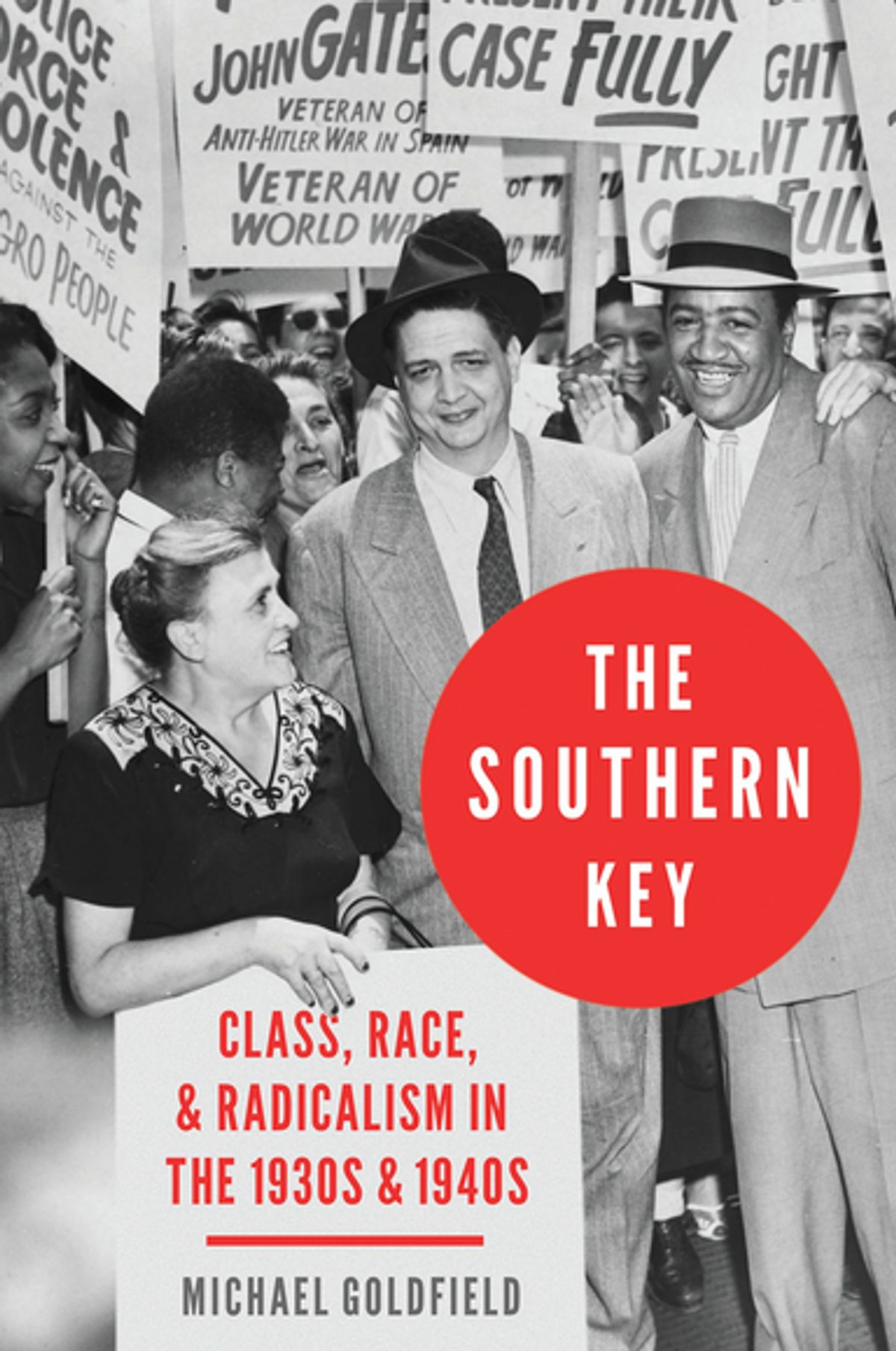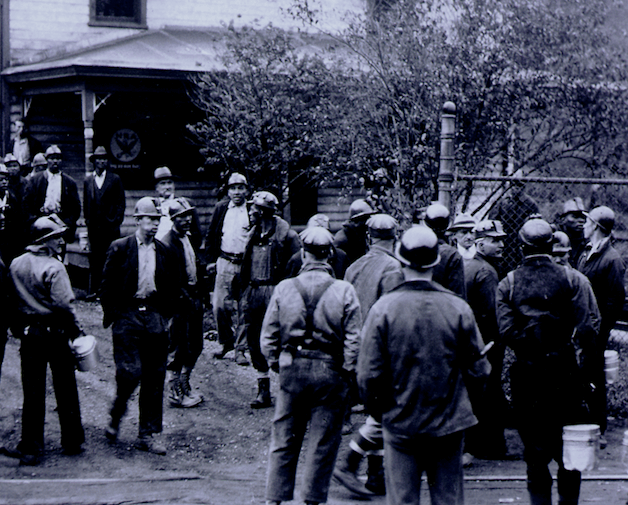Today we begin a roundtable discussion on Michael Goldfield’s new book, The Southern Key: Class, Race, and Radicalism in the 1930s and 1940s. Goldfield examines the failure to organize the South in the period of the workers insurgency of the 1930s and 1940s. He argues that the fate of the South determined the fate of the nation, and that unionization was the key to transforming the region. He asks important questions about whether it could have been organized, examining an extensive array of published and archival sources.

We will post a new contribution to the roundtable each day for most of the week. The four roundtable commentators focus on key themes in Goldfield’s book. Here is our schedule:
July 13: James Gray Pope discusses the key premises of The Southern Key, suggests the evidence Goldfield presents makes for a usable history, and he suggests they raise important questions about the role of democracy in unions and radical organizations. July 14: Ahmed White focuses on Goldfield’s treatment of the Steelworkers union, and then raises important questions about the counterfactuals and repression. July 15: William Jones questions whether Goldfield has addressed the intersection between law and politics adequately, and suggests he neglects the organizing that continued outside the Communist Party orbit. July 16: Rosemary Feurer appreciates Goldfield’s survey of the South through “an organizer’s eye,” especially his discussion of the potential of timber and wood workers, but wishes he had contributed a more sustained discussion of how Left organizing was distinctive. July 17: Michael Goldfield writes a robust rejoinder to the key themes and questions raised by the reviewers.
Civil Rights and Democracy in Michael Goldfield’s the Southern Key — by James Pope

In Michael Goldfield’s fascinating new book, the South is key, and the labor movement of the North and West held the key to the South during the critical decades of the 1930s, 1940s, and 1950s. The South is key because “its political transformation holds the central lever for transforming the United States as a whole.” (8) From the outset, says Goldfield, the South has acted as a “reactionary drag” on U.S. politics. Every advance in equality and democracy has been met with a ferocious southern reaction, from the abolition of slavery to the civil rights movement of the 1950s and 1960s. This part of the argument flows naturally from Goldfield’s earlier opus, The Color of Politics which may well be the best, single-volume treatment of American political dynamics yet written.
The new book argues that things could have turned out differently. The upsurge of industrial unionism in the 1930s and 1940s spawned a labor-based civil rights movement anchored in left-led CIO unions and sustained by close connections with civil rights formations. When given a chance, this movement demonstrated that white workers could be won to support Black rights, in both industrial and electoral arenas. In Alabama, for example, industrial workers joined with up-country whites in 1946 to elect Governor Jim Folsom, a left-populist who backed Black voting rights and supported equal opportunity.
Unfortunately, however, the CIO failed to organize such key southern industries as textile and woodwork, and the southern branches of existing industrial unions turned away from the struggle for civil rights. These developments set the table for Nixon’s southern strategy. “What allowed the white backlash to be so dominant,” says Goldfield, “was the limited (white) working-class opposition to it.” (370).
How might a different outcome have been achieved? By bringing the power of the industrial union movement, developed in the more industrially and politically advanced North and West, to bear on the South. Goldfield lays out a counterfactual with several crucial components.
First, Sidney Hillman would have directed the Textile Workers Organizing Committee (TWOC) of 1937-1938 to rely not on the government but on strike action to enforce the workers’ right of self-organization guaranteed by the newly upheld National Labor Relations Act (NLRA). Goldfield makes a strong case that the TWOC, which was better funded than the much-ballyhooed Operation Dixie of 1946, had a real chance to organize the more than 400,000 southern textile workers despite the recession of 1937-1938. But Hillman failed to understand that southern textile magnates would respond only to direct action, and not to delay-prone and weak government enforcement of workers’ rights. Although Goldfield suggests that Hillman was ideologically predisposed against direct action, his response to section 7(a) of the National Industrial Recovery Act three years earlier suggests otherwise. “Section 7(a) can be enforced through strikes,” he said then, and his Amalgamated Clothing Workers implemented that policy on the ground, not only threatening and leading strikes, but also granting full support to spontaneous strikes staged by local activists.[1] And when it appeared that the Supreme Court would invalidate the NLRA, Hillman not only called for open defiance, but went so far as to proclaim that four years of Civil War had overturned the Dred Scott decision, and “we can do the same for wage slavery.”[2] Hillman can certainly be criticized for overemphasizing legal reform at the expense of worker self-activity generally, but – in this case – it appears that he simply overestimated the capacity of the newly upheld NLRA, with its superficially impressive enforcement mechanisms, to constrain capitalists operating in reactionary political environments.
Second, liberal CIO leaders like John L. Lewis and Phillip Murray would have worked with radical labor leaders and organizers instead of marginalizing and eventually purging them. As Goldfield points out, radicals tended to be more competent, committed, and effective than the more pliable and respectable liberals favored by CIO leaders. Communists, in particular, often stood head and shoulders above others in their determination to fight racism. While many liberals questioned whether Black workers were organizable, most Communists not only held that they were crucial to the development of strong industrial unions, but also courageously implemented that policy on the ground. Here, Goldfield draws effectively on his own and others’ recent work in recounting the impressive ability of Communist-led unions to promote Black civil rights while building union strength even in such difficult locations as Port Arthur, Texas, and Birmingham, Alabama. When CIO leaders ousted the popular and aggressive left leadership of the International Woodworkers of America (IWA), he argues, they gave up a golden opportunity to establish interracial, industrial unionism in the South’s second largest industry.
Finally, the Communist Party would have had to refrain from repeatedly undermining labor radicals, including its own union cadres. Goldfield stresses the popular front period, when Party officials sucked up to liberal unionists who were already maneuvering to purge Party members from union leadership. (358, 240) Here, in my opinion, the counterfactual runs into difficulty. As Goldfield points out, the root of the Party’s failures lay in its subservience to the Soviet Union. After the Third International’s 1928 shift from world revolution to socialism in one country, Communists around the world found it difficult, if not impossible, to distinguish between the interests of the working class and those of the Soviet nation state. Some of the Third International’s Soviet-directed line changes appeared arbitrary and destructive to militant workers, and the CPUSA implemented them so zealously that it accumulated a record of “perfidy, unprincipled behavior, and outright treachery” sufficient to earn the undying enmity of many labor progressives and, as others have written, to provide an experiential grounding for anti-Communism in the CIO. (365) Could the Party have escaped this pattern? It is difficult to imagine a clean break, because the Party’s position of leadership on the American left hinged on its connection with the world Communist movement which, in turn, was dominated by Stalin.
Whatever the probability that Goldfield’s counterfactual could have been realized, there is plenty of usable history in this book. Especially significant, from my point of view, is Goldfield’s treatment of democracy – both in unions and in radical organizations. Bad things happen when democratic principles are flouted. CIO leaders, for example, deployed thuggery and redbaiting to oust the elected leadership of the IWA, leftists who were committed to organizing the South. And Communist Party leaders autocratically imposed policies thought to benefit the Soviet Union, including support for the Hitler-Stalin pact and the wartime no-strike pledge.

Probing more deeply, Goldfield’s stress on democracy might be usefully connected to the work of Staughton Lynd and others who have emphasized the leadership role and structural importance of rank-and-file activists. As Lynd demonstrated in his pathbreaking account of the 1933 upsurge in steel, local activists could at times provide better leadership than either union officials or national left organizations.[3] Arguably, the same was true in many industries, including – as Goldfield recounts – coal, seedbed of the 1930s upsurge.[4] Unions scored some of their greatest successes when they supported spontaneous organizing, backed strikes staged by local militants, and spread organizing into new locations, as did the Amalgamated and the ILG in 1933 and the United Rubber Workers in 1936. In a number of cases, local activists built industrial unions in the teeth of opposition from union officials, for example in longshore, trucking, and – most spectacularly – coal. Communists and other labor radicals were often involved, but at times they succeeded only by defying their national organizations, as did Communists in most industries in 1933, when they avoided isolation by joining co-workers to seek industrial codes under the National Industrial Recovery Act at a time when Party leaders were urging workers to boycott the code-making process.
On the central problem of winning white workers to support Black rights, however, democracy and local initiative provided no solution. This was particularly true in the South, where white racial solidarity had long been enforced through the illegal, but judicially protected, suppression of Black and integrated worker organizing. Only in a few industries and locations, most prominently coal mining and New Orleans longshore, had workers at times succeeded in cooperating across racial lines. Here, Goldfield’s account is at its most compelling. Communists, along with a few other radicals, stood out for their commitment to racial equality and their willingness to put their bodies on the line. CIO leaders, on the other hand, failed to see the vital importance either of Black workers or of cross-racial solidarity. They aggressively undermined Communist union leaders and excluded Communist organizers from key campaigns. While trumpeting their determination to organize the South, they ignored its second largest industry partly because African Americans made up a substantial portion of the workforce. As Goldfield points out, success would not necessarily have required that CIO leaders sincerely embrace anti-racism; it might have been enough if they had followed the same policy of opportunism that had led John L. Lewis to work closely with Communists in other regions.
[1] Steven Fraser, Labor Will Rule 290 (1991).
[2] President Hillman Calls for Membership Mobilization in Defense of Amalgamated Standards, Advance, June 15, 1935, at 3; Gertrude Weil Klein, Men’s Clothing Workers Ready For Big Battle, New Leader, June 8, 1935, at 1.
[3] Staughton Lynd, The Possibility of Radicalism in the Early 1930s: The Case of Steel, in Staughton Lynd, Living Inside Our Hope (Ithaca: ILR Press, 1997).
[4] See Staughton Lynd ed., “We Are All Leaders”: The Alternative Unionism of the Early 1930s (Urbana: U. Ill. Press, 1996); Goldfield, Southern Key, at 64-67.





